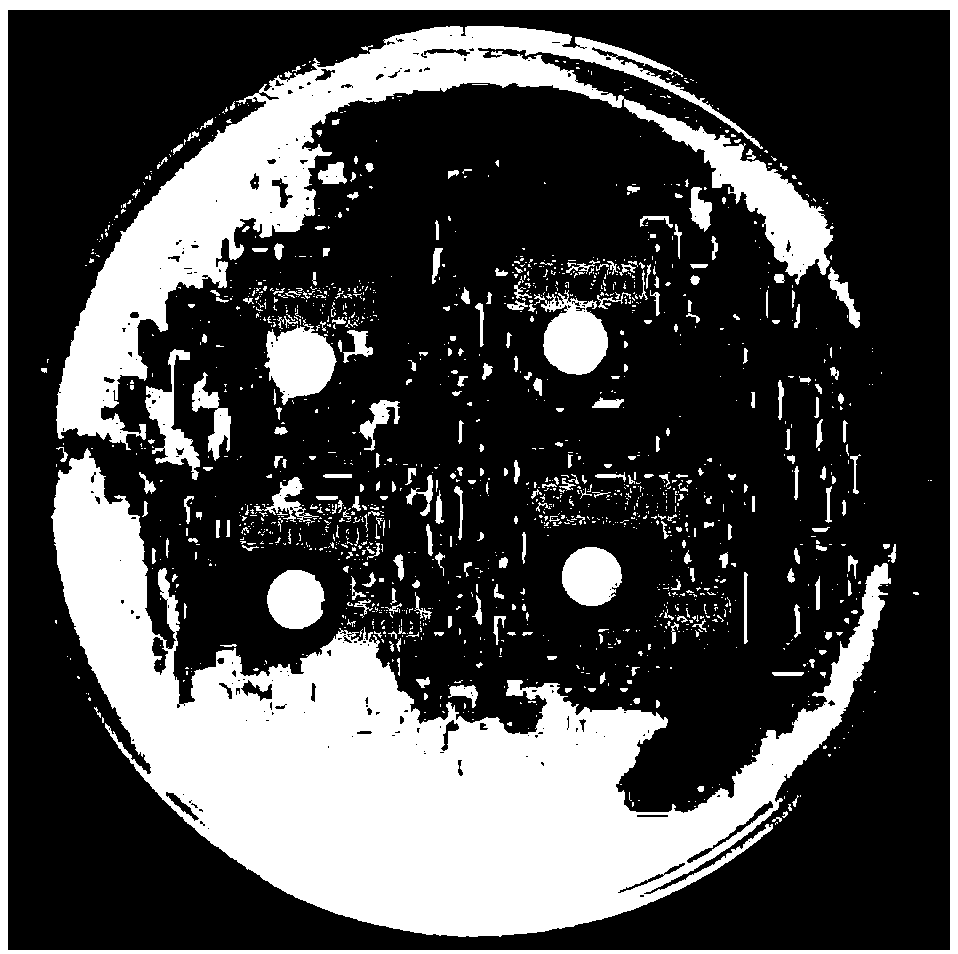Preparation method for silver-containing carbon dot and application of silver-containing carbon dot to preparation of antibacterial agent
A silver-carbon and carbon dot technology, applied in the field of biomaterials, can solve the problems of poor biocompatibility of Cd quantum dots, and achieve the effects of good photostability, strong bacteriostatic function, and avoiding the harm of the natural environment.
- Summary
- Abstract
- Description
- Claims
- Application Information
AI Technical Summary
Problems solved by technology
Method used
Image
Examples
Embodiment 1
[0045] (1) Take by weighing 0.1gPEI (molecular weight is 1800), 0.5g citric acid is in the round bottom flask of 50mL, then inject the silver nitrate of 50μL 0.1mol / L, add the ultrapure water of 30mL again and make it mix evenly, in After stirring for 20 min under the protection of nitrogen, a mixed solution was obtained.
[0046] (2) Transfer the mixed solution obtained in step (1) into a microwave reactor and heat it to 200° C., and react for 30 minutes to obtain the PEI-Ag carbon dot solution.
[0047] (3) Mix the PEI-Ag carbon dot solution obtained in step (2) with methanol at a volume ratio of 1:5, centrifuge at 5000 rpm for 30 minutes, remove the supernatant, and freeze-dry the resulting precipitate to obtain solid PEI-Ag carbon dots. point.
[0048] To dissolve in 0.1mol / L H 2 SO 4 Quinoline sulfate in solution (refractive index (η) 1.33) was used as reference (quantum yield=54%). By comparing the fluorescent area (E x =360nm) and the ratio of absorbance to calcula...
Embodiment 2
[0057] (1) Weigh 0.1g PEI (molecular weight is 600), 2g of citric acid in a 50mL round bottom flask, add 30mL of ultrapure water to mix evenly, stir for 20min under the protection of nitrogen, then pour into the round bottom flask 100μL of 0.1mol / L silver nitrate, and continue to stir for 20min.
[0058] (2) Transfer the mixed solution obtained in step (1) into a microwave reactor and heat it to 220° C., and react for 5 minutes to obtain the PEI-Ag carbon dot solution.
[0059] (3) Place the PEI-Ag carbon dot solution obtained in step (2) directly in a 3KD ultrafiltration centrifuge tube, centrifuge at 12,000 rpm for 10 minutes, remove the lower layer solution, and dry the upper layer solution with nitrogen to obtain solid PEI-Ag carbon dots. point. By measurement, the quantum yield of the PEI-Ag carbon dots synthesized in Example 2 is 55.5%.
[0060] (4) Inoculate Staphylococcus aureus in the MH broth liquid medium, place it in a constant temperature shaker, and cultivate i...
Embodiment 3
[0063] (1) Weigh 0.1g PEI (molecular weight 10000), 1g citric acid in a 50mL round bottom flask, add 30mL ultrapure water to the round bottom flask to mix evenly, and stir for 20min under the protection of argon.
[0064] (2) Transfer the mixed solution obtained in step (1) into an autoclave and heat it to 220° C., and react for 30 minutes to obtain the PEI carbon dot solution.
[0065] (3) Inject 30 μL of 0.1mol / L silver nitrate into the PEI carbon dot solution, and stir for 20 min under the protection of argon to obtain the PEI-Ag carbon dot solution.
[0066] (3) Mix the PEI-Ag carbon dot solution obtained in step (3) with acetonitrile in a volume ratio of 1:2, centrifuge at 15000rpm for 5min, remove the supernatant, and dry the resulting precipitate with argon to obtain solid PEI-Ag Ag carbon dots. By measurement, the quantum yield of the PEI-Ag carbon dots synthesized in Example 3 was 53.3%.
[0067] (4) Inoculate the Candida albicans strains in the improved Martin liqu...
PUM
 Login to View More
Login to View More Abstract
Description
Claims
Application Information
 Login to View More
Login to View More - R&D
- Intellectual Property
- Life Sciences
- Materials
- Tech Scout
- Unparalleled Data Quality
- Higher Quality Content
- 60% Fewer Hallucinations
Browse by: Latest US Patents, China's latest patents, Technical Efficacy Thesaurus, Application Domain, Technology Topic, Popular Technical Reports.
© 2025 PatSnap. All rights reserved.Legal|Privacy policy|Modern Slavery Act Transparency Statement|Sitemap|About US| Contact US: help@patsnap.com

